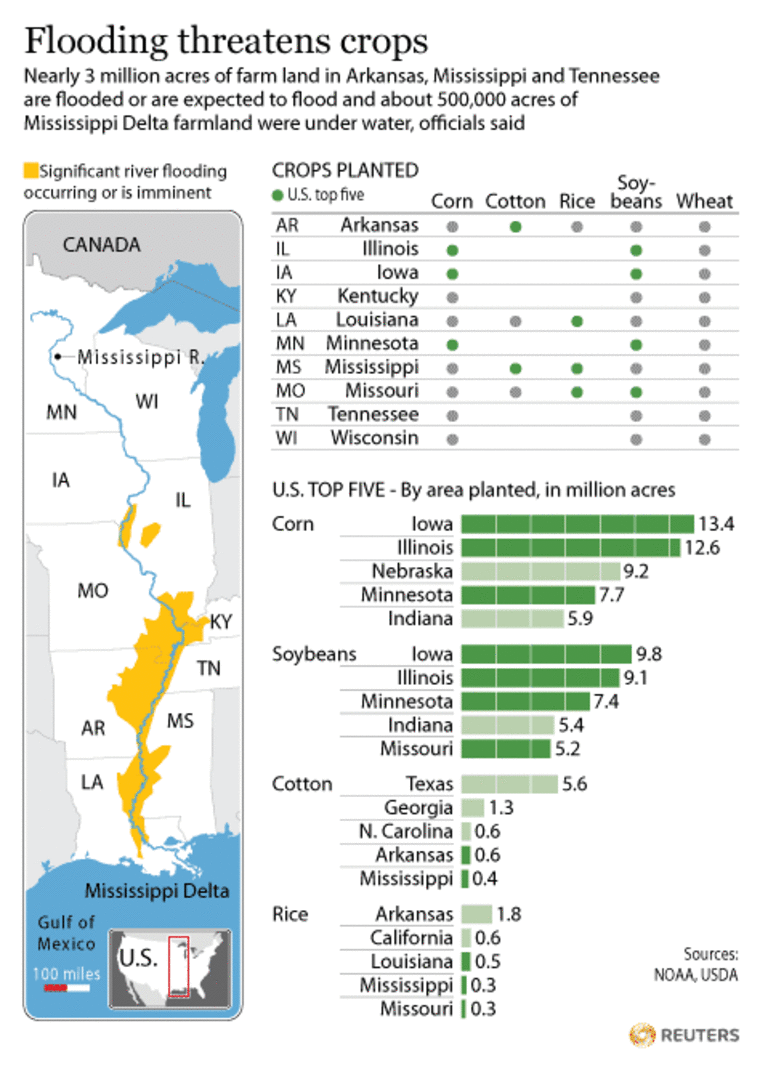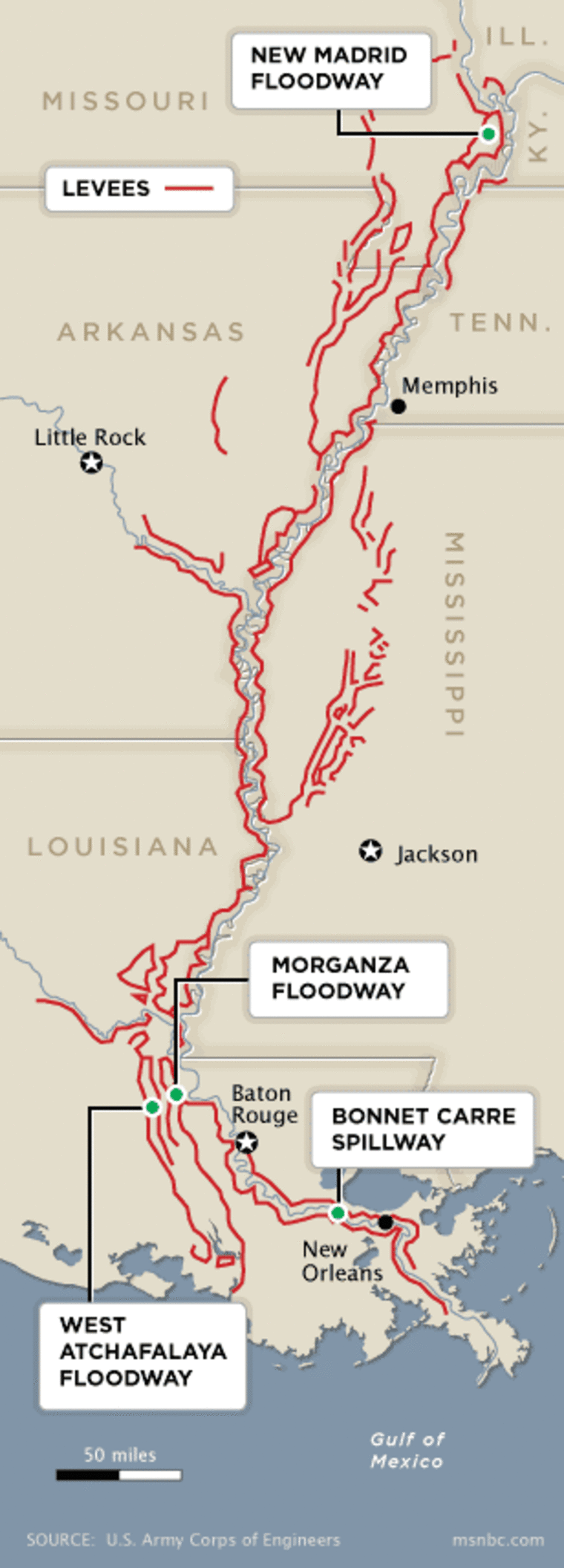In an agonizing trade-off, Army engineers said they will open a key spillway along the bulging Mississippi River as early as Saturday and inundate thousands of homes and farms in Louisiana's Cajun country to avert a potentially bigger disaster in Baton Rouge and New Orleans.
About 25,000 people and 11,000 structures could be in harm's way when the gates on the Morganza spillway are unlocked for the first time in 38 years.
"Protecting lives is the No. 1 priority," Army Corps of Engineers Maj. Gen. Michael Walsh said aboard a boat from the river at Vicksburg, Miss., hours before the decision was made to open the spillway.
Opening the spillway will release a torrent that could submerge about 3,000 square miles but take the pressure off the downstream levees protecting New Orleans, Baton Rouge and the numerous oil refineries and chemical plants along the lower reaches of the Mississippi.
Engineers feared that weeks of pressure on the levees could cause them to fail, swamping New Orleans under as much as 20 feet of water in a disaster that would have been much worse than Hurricane Katrina in 2005.
Instead, the water will flow 20 miles south into the Atchafalaya River. From there it will roll on to the Gulf of Mexico, flooding swamps and croplands. Morgan City, an oil-and-seafood hub and a community of 12,000, shored up levees as a precaution.
The corps said it will open the gates when the river's flow rate reaches 1.5 million cubic feet per second and is predicted to keep rising, which is expected sometime Saturday. Just north of the spillway at Red River Landing, the river had reached that flow rate, according to the National Weather Service.
But some people living in the threatened stretch of countryside — an area known for small farms, fish camps and a drawling French dialect — have already started fleeing for higher ground.
Sheriffs and National Guardsmen will warn people in a door-to-door sweep through the area, Gov. Bobby Jindal said. Shelters are ready to accept up to 4,800 evacuees, the governor said.

"Now's the time to evacuate," Jindal said. "Now's the time for our people to execute their plans. That water's coming."
The Army Corps of Engineers employed a similar cities-first strategy earlier this month when it blew up a levee in Missouri — inundating an estimated 200 square miles of farmland and damaging or destroying about 100 homes — to take the pressure off the levees protecting the town of Cairo, Ill., population 2,800.
This intentional flood is more controlled, however, and residents are warned by the corps each year in written letters, reminding them of the possibility of opening the spillway.
At a meeting earlier Friday, Army Corps of Engineers Col. Ed Fleming warned a crowd at a volunteer fire station in rural Butte LaRose that where they were standing was projected to be swamped by up to 15 feet of water from Mississippi River flooding. The crowd let out a collective gasp.
"From the ground?" an incredulous resident shouted.
"From the ground," replied Fleming, head of the corps' New Orleans district.
Opening the gates for the first time in 38 years will unleash the Mississippi on a wild ride south to the Gulf of Mexico through the Atchafalaya River and divert floodwater from the river into the basin's swamplands, backwater lakes and bayous. Several thousand homes would be at risk of flooding.
Even if engineers decide not to open the spillway, no one seems to doubt that a major flood is bound for Butte LaRose, Krotz Springs, the oil-and-seafood hub of Morgan City and other swampland communities in the Atchafalaya Basin.
The Morganza and the nearby Old River Control Structure were built in the 1950s to keep the Mississippi on its current course through New Orleans, one of the world's busiest ports. If the river rises much higher at New Orleans, the Coast Guard said it would consider restrictions on shipping, including potentially closing the channel to the largest, heaviest ships.
Shipping interests have pushed for the opening of the Morganza, saying the move would keep ships cruising. If the river closes, history shows the costs grow quickly into staggering figures.
In 2008, a 100-mile stretch of the river was closed for six days after a tugboat pushing a barge collided with a tanker ship, spilling about 500,000 gallons of fuel and stacking up ships. The Port of New Orleans, citing an economic impact study it commissioned, estimated the shutdown cost the national economy up to $275 million a day.
For the people of this region, river flooding and hurricanes are familiar hazards. Floodwaters damaged or destroyed many homes and fishing camps in Butte LaRose in 1973, the last time the corps opened the Morganza.
'Typical bull-headed Cajun'
Maxim Doucet was born that year. His parents stayed put, even when the floodwaters started lapping at the rear of their grocery store.
Doucet has no intention of leaving town this time, either. The water didn't seep into the store when the flood gauge hit 27 feet in 1973, so Doucet can't believe the center of town will be submerged in 15 feet of water.

While most of his neighbors were packing up, Doucet deployed a team of workers and heavy machinery to erect a 6-foot levee around his home on the banks of the Atchafalaya River. A dump truck hauled in roughly 1,000 cubic yards of clay for a bulldozer and front-end loader to fashion a protective ring around the rear of Doucet's three-story house.
"I figured I'd give Mother Nature a run for her money," said Doucet, who owns a construction company called Monster Heavy Haulers.
The state Department of Wildlife and Fisheries has not announced any plans to cut short commercial or recreational fishing seasons in anticipation of Morganza's opening, but a spokeswoman said officials will monitor the situation.
If the corps gets permission to open half of Morganza's 125 gates, water from the Mississippi is expected to arrive in Butte LaRose in about one day. Within three days, it would reach Morgan City, a community of about 12,000.
Morgan City Mayor Timothy Matte said the main floodwalls should be able to handle the river's frontal attack, but he was less certain about the back levees that protect the city from floodwaters that collect in lakes north of town. He said the waters could reach within a foot of the top of those levees.
"It is very close to the top," he said.
'Sacrificial lambs'
On Thursday, two shipyards were closed in preparation for the arrival of high water, but the town's riverboat casino remained open. In Butte LaRose, inmates from the St. Martin Parish jail filled sandbags for residents to pick up. Some wondered if it was a futile gesture.
Teresa Meyerer said basin communities are being treated like "sacrificial lambs."
"They say it's for the good of the metropolitan areas," she said. "I've seen what they do in metropolitan areas. They pave paradise and put up a parking lot. Is the destruction worth it for dollars?"
Meyerer fought back tears as she packed her belongings in plastic bags and loaded some of her cherished paintings and art supplies into the back of her car. The camp she bought in Butte LaRose 13 years ago is her "salvation." On weekend retreats from her Baton Rouge home, she can fish off a deck and watch eagles hunt.
"I doubt if I'll ever come back here," she said.
As people gathered at the Butte LaRose volunteer fire station to hear Fleming deliver his ominous forecast of so much water, a few skeptics scoffed, but many were shaken.
"It's over with," muttered Pierre Watermeyer. "That's it. There's no sense in pretending."